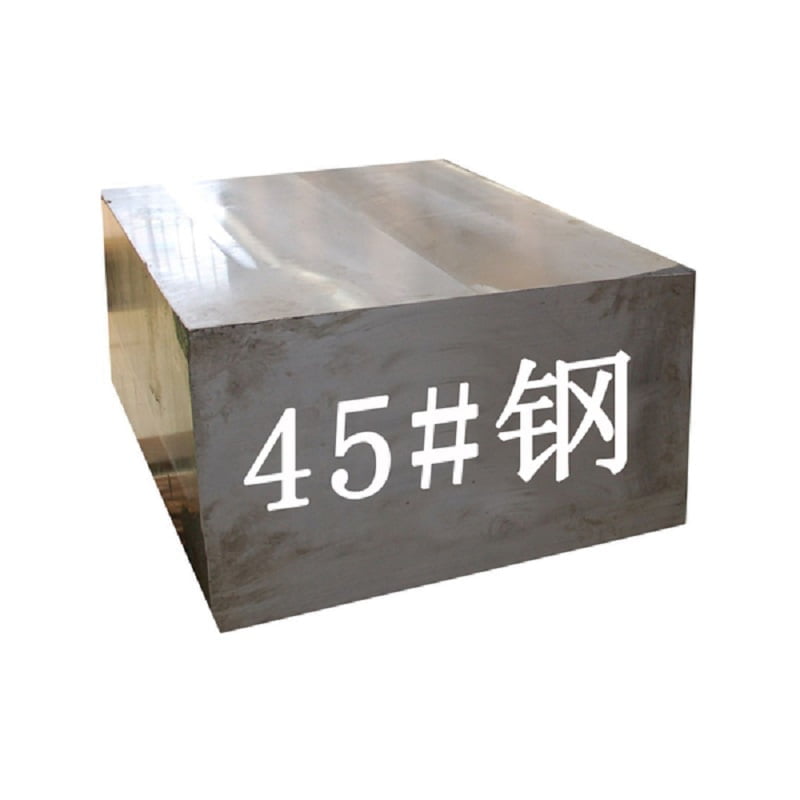
소개
S45C 및 S55C는 다양한 엔지니어링 및 제조 응용 분야에서 일반적으로 사용되는 인기 있는 등급의 중탄소강입니다. 이 기사에서는 더 나은 명확성과 이해를 위해 표를 활용하여 화학적 조성, 기계적 특성, 열처리 반응, 적용 및 장점/단점을 제시하는 S45C와 S55C의 자세한 비교를 제공합니다.
화학적 구성 요소
강철 등급의 화학적 조성은 기계적 특성과 특정 용도에 대한 적합성을 결정하는 데 중요합니다.
| 요소 | S45C 구성(%) | S55C 구성(%) |
|---|---|---|
| 탄소(C) | 0.42% – 0.48% | 0.50% – 0.60% |
| 망간(Mn) | 0.60% – 0.90% | 0.60% – 0.90% |
| 인(P) | 0최대 0.03% | 0최대 0.03% |
| 유황(S) | 0최대 0.03% | 0최대 0.03% |
화학 성분의 설명
- 탄소(C): 가장 큰 차이점은 탄소 함량입니다. S45C의 탄소 함량은 0.42%~0.48%인 반면, S55C의 탄소 함량은 0.50%~0.60%로 약간 더 높습니다. S55C의 탄소 함량이 높을수록 경도와 강도가 향상됩니다.
- 망간(Mn): 두 재종 모두 유사한 범위의 망간을 함유하고 있으며 이는 강의 탈산 및 경화성 향상에 중요합니다.
- 인(P) 및 황(S): 이는 강철의 불순물로 간주됩니다. 두 등급 모두 최대 허용 비율이 동일하므로 취성을 줄이는 데 도움이 됩니다.
기계적 성질
기계적 특성은 다양한 스트레스 요인 하에서 재료가 어떻게 작동하는지 결정하는 데 중요합니다.
| 재산 | S45C | 우수한 가공성 및 용접 수리성 |
|---|---|---|
| 항복강도(MPa) | 약 355MPa | 약 400MPa |
| 인장 강도(MPa) | 570~700MPa | 650 – 800MPa |
| 신장률(%) | 14%(최소) | 12%(최소) |
| 경도(HB) | 170 – 210HB | 190 – 230HB |
기계적 성질에 대한 자세한 설명
- 항복 강도: S55C는 S45C보다 항복강도가 높아 변형되기 전 더 큰 응력을 견딜 수 있습니다.
- 인장 강도: S55C의 인장강도는 S45C보다 우수하여 하중을 많이 받는 용도에 더 적합합니다.
- 연장: 연신율은 강철이 파손되기 전에 늘어나는 능력을 말합니다. S45C는 더 높은 연신율을 나타내며 이는 더 많은 소성 변형을 겪을 수 있음을 나타냅니다.
- 경도: S55C는 일반적으로 S45C보다 단단하여 내마모성이 우수합니다.
열처리 반응
열처리는 탄소강의 기계적 특성에 큰 영향을 미칠 수 있습니다.
| 열처리 유형 | S45C | 우수한 가공성 및 용접 수리성 |
|---|---|---|
| 담금질 | 담금질 처리를 통해 경화 가능 | 담금질을 통해 더 높은 경도를 얻을 수 있습니다. |
| 템퍼링 | 강도를 유지하면서 취성을 감소시킵니다. | 경도를 유지하면서 인성을 향상시킵니다. |
열처리 설명
- 담금질: 두 등급 모두 담금질로 경화할 수 있으나, S55C는 탄소 함량이 높기 때문에 담금질 후 경도가 높아지는 경향이 있습니다.
- 템퍼링: 담금질 후 뜨임 공정을 통해 인성을 향상시키고 잠재적인 취성을 줄일 수 있으며, 이는 충격 하중을 견뎌야 하는 부품에 필수적입니다.
애플리케이션
S45C, S55C는 기계적 특성에 따라 다양한 용도로 사용됩니다.
| 애플리케이션 | S45C | 우수한 가공성 및 용접 수리성 |
|---|---|---|
| 기어 | 일반적으로 사용되는 | 고응력 기어에 적합 |
| 샤프트 | 자주 사용됨 | 고성능 샤프트에 사용 |
| 기계 부품 | 일반 엔지니어링 부품 | 더 높은 강도가 요구되는 부품 |
| 도구 | 일반적으로 사용되지 않음 | 절삭공구 및 다이에 적용 가능 |
| 자동차 부품 | 자주 사용됨 | 중요한 응용 분야(예: 크랭크샤프트) |
적용 설명
- S45C: 강도와 가공성이 균형잡혀 있어 기어, 샤프트 등 일반 엔지니어링 용도에 적합합니다.
- 우수한 가공성 및 용접 수리성: 탄소 함량이 높을수록 절삭 공구 및 고성능 자동차 부품과 같이 더 높은 강도와 경도가 요구되는 응용 분야에 적합합니다.
장점과 단점
S45C와 S55C 모두 고유한 장점과 단점이 있습니다.
| 측면 | S45C | 우수한 가공성 및 용접 수리성 |
|---|---|---|
| 장점 | – 가공성이 좋음 | – 더 높은 강도와 경도 |
| – 일반 응용 분야에 비용 효율적 | – 우수한 내마모성 | |
| – 균형 잡힌 속성 | – 스트레스가 많은 환경에 적합 | |
| 단점 | – S55C에 비해 강도가 낮음 | – 가공성 감소 |
| – 제한된 경도 | – S45C에 비해 가격이 높음 |
장점과 단점에 대한 자세한 설명
- S45C의 장점: 가공성과 경제성이 뛰어나 다양한 일반 엔지니어링 용도에 적합합니다.
- S45C 단점: 낮은 강도와 경도로 인해 고응력 적용 분야에서는 효율성이 제한될 수 있습니다.
- S55C의 장점: 강도와 내마모성이 강화되어 까다로운 용도에 적합합니다.
- S55C 단점: 경도가 높아지면 가공이 어려워져 생산 비용이 높아질 수 있습니다.
결론
S45C와 S55C 중에서 선택하려면 애플리케이션의 특정 요구 사항을 신중하게 고려해야 합니다. S45C는 강도와 가공성의 균형을 제공하여 일반 엔지니어링 용도에 적합하며, S55C는 강도와 경도가 높아 응력과 마모 시 향상된 성능이 필요한 응용 분야에 이상적입니다. 화학 성분, 기계적 특성, 열처리 반응 및 응용 분야의 차이를 이해하면 엔지니어와 제조업체가 프로젝트 요구 사항에 맞는 정보를 바탕으로 재료를 선택하는 데 도움이 됩니다.
